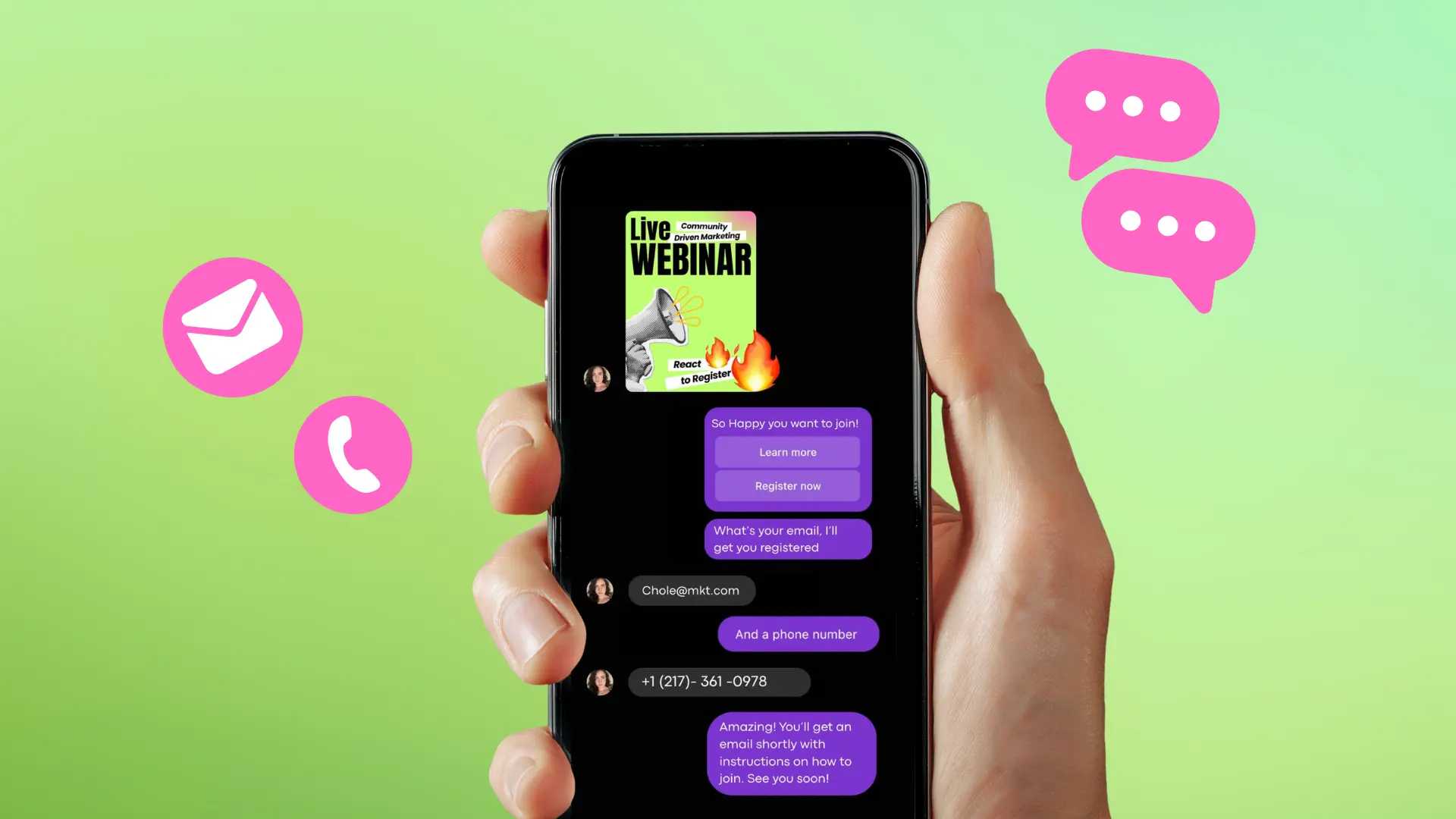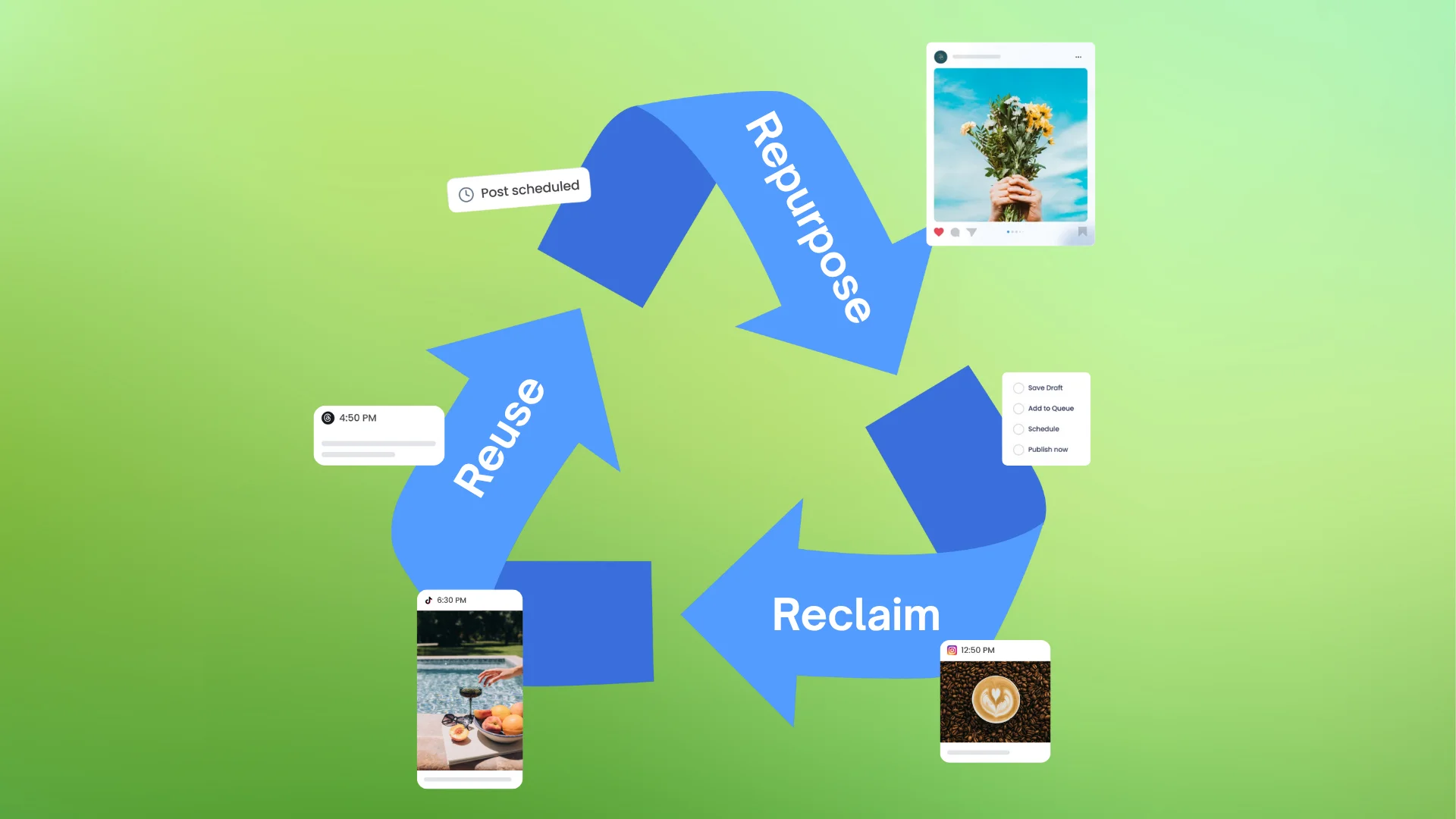New

Turn Your DMs Into Lead Gen!
Learn how to collect lead data from your DMs such as email addresses, phone numbers, and more right from your social inbox. If you are not yet automating your DMs your competitors are outpacing you.

How Something Social Saved 75% of Their Time and Increased Revenue by 15%
See how a fast-growing agency improved operations, cut down hours of manual work, and unlocked new revenue opportunities with Vista Social.
New

50 Unique Social Media Ideas for Consistent Content Creation
Discover 50 unique social media post ideas to engage your audience, grow your brand, and maintain a consistent content strategy with ease!

Mastering Content Reuse: The Key to a Consistent and Sustainable Posting Strategy
Published on August 14, 2025
11 min to read
How to Hire a Social Media Manager Without Wasting Budget
Summarize with AI


Table of Content

When you hire a social media manager, it can be one of your brand’s biggest assets…or expenses. A great social media manager does more than post—they strategize, analyze, and drive growth. So whether you’re a startup or a growing brand, finding the right person can significantly impact your ROI.
According to a US survey, a single bad hire can cost your business an average of a whopping $17,000. Whether it’s unrealistic hiring expectations or not looking on the right platforms, these common pitfalls can make your hiring process a costly learning experience with very little return.
So, how do you hire a social media manager strategically and effectively? In this guide, we’ll tackle strategic hiring tips to help you make smarter decisions for your business—giving you the best value of every penny spent.
Table of contents
Signs It’s Time to Hire a Social Media Manager
Hiring a social media manager may generally be considered a luxury for some, but in reality, it’s often a necessary step in managing your brand efficiently. If any of these signs sound familiar, it may be time to delegate:
- You’re spending too much time managing platforms: If you find yourself juggling content creation, post scheduling, inbox management, and jumping between apps—all while running your actual business… then it might be time to outsource. Instead of risking burnout or your operations, remember that your time is better spent on strategy, not execution.
- Your content strategy feels disorganized or inconsistent: Posting whenever you remember? Hopping on random trends with no clear goal? Inconsistent or unintentional content brings more confusion to your audience, undermining your brand identity and trust. When there’s no clear direction or calendar for what goes out and when, a social media manager is the right call for rebuilding structure.
- Engagement rates are stagnant or declining: You’re showing up regularly, yet your likes, shares, and comments aren’t budging—or worse, they’re dropping. That signals an imbalance between your content and your audience. When you hire a social media manager, they can diagnose what’s not working, optimize content types, and revive engagement through precision targeting and creative formats.
- You’re launching new products and need professional promotion: Product launches aren’t just about a one-time post. They require storytelling, teaser campaigns, strategies such as ads and influencer partnerships, and real-time engagement. So if you’re planning new product launches, having someone like a social media manager to manage rollout is crucial to making an impact and maximizing sales. As they say, better safe than sorry!
- You lack performance tracking or analytics insights: If you don’t know what’s working or how your content is performing across platforms, then you’re blindly hoping. Without analytics, there’s no way to know which strategies are driving results, which content is converting, or how your audience is growing. With a social media manager, you can convert this data into smart decisions, allowing you to refine your strategies for growth opportunities.
[Must Read: Essential Social Media Metrics to Track for Success in 2024]
Setting a Realistic Budget Before Hiring
Before diving into job hiring platforms or reaching out to agencies, it’s important to take a step back and evaluate your budget. A social media manager can drive real business growth, but only if the hire’s benefits truly outweigh the costs.
At this point, you may be wondering… how much do social media managers usually cost? While the costs vary, it usually depends on the model you choose: freelancer, full-time employee, or agency. Here’s a quick breakdown of the pros, cons, and price points:
Freelancers
On Upwork alone, freelancers typically charge anywhere from $14 to $35 per hour, depending on the scope and their expertise. Whether hourly or monthly rates, this hiring setup is perfect for startups, project-based work, or short-term campaigns.
Advantage: Flexibility and specialized skills. However, because freelancers often juggle multiple clients, their availability can fluctuate, which may impact turnaround time or responsiveness.
Full-time Employees
While it depends on the business size, expertise, and scope of services, a small business can spend anywhere from $500 to $1,500 per month for basic social media manager services. This option is best suited for brands that want a consistent and stronger alignment for long-term growth.
Advantage: Full-time hires may bring deeper reliability, but they also come with added expenses such as tools, benefits, onboarding, training, and equipment (which we will also tackle in this blog!)
Agencies
On the other hand, agencies usually charge between $1,000 and $10,000 per month, depending on the services provided. This is a great fit for businesses that want an entire team working on strategy, content creation, and analytics.
Advantage: They offer end-to-end service and access to niche experts, but can be more expensive and sometimes lack the personalized attention that in-house or freelance options provide.
[Must Read: How to Start a Social Media Management Business? 10 Tips for Agencies]
Aside from their salary ranges, it’s important to consider other costs such as tools, training, and benefits. Because they’re often overlooked, these expenses can cause major budget overruns.
For example, essential tools like Vista Social for social media management and Canva Pro for designing and content creation typically require monthly or annual subscriptions. Moreover, if your new hire is unfamiliar with your brand’s tone, values, or processes, then it’s wise to allocate resources for their training and onboarding.
Without this, you may risk productivity and consistency—and eventually, your results. Lastly, you’ll also need to factor in benefits like insurance, paid leave, and other perks—especially for full-time employees.
[Must Read: From Planning to Posting: The Top Tools Every Social Media Manager Swears By]
If you’re now sure you want to hire a social media manager, but don’t know how to take the plunge yet? Take these tips as your beginner-friendly guide:
- Start with a monthly cap: If your goal is to test the waters, it’s best to set a maximum monthly spend and stick to it. Determine what percentage of your overall marketing budget can be reasonably allocated to social media, depending on your goals.
- Consider short-term contracts or trial projects: This setup is perfect for those who don’t want to commit long-term just yet! Before locking into a long-term hire or retainer, try a trial period such as a 2 to 4-week paid project. This lets you assess their ability, match expectations to results, and communicate effectively—without draining your budget on blind directions.
- Allocate budget for tools (like Vista Social): Hiring a social media manager is only half the battle—they’ll also need tools to deliver efficiently. But here’s the catch: when you have the right person but the wrong tools… the hire goes to waste! So, ensure to allocate a budget and invest wisely in quality tools like Vista Social, a comprehensive all-in-one social media management tool.
What to Look For in a Social Media Manager
Hiring the right social media manager goes beyond finding someone who knows how to post consistently. You need someone who understands your brand, engages your audience, and contributes to business growth through strategy and insight. Once you’ve set your mind on the perfect work setup, here are some of the key qualities and competencies to also keep in mind:
Skills & Experience
Look for candidates who bring a well-rounded set of technical skills and relevant experience. These are the day-to-day essentials that will keep your brand competitive and visible across social platforms:
- Platform expertise (TikTok, Instagram, LinkedIn, etc.)
- Copywriting and content creation
- Analytics and reporting
- Community engagement
- Ad management
Industry Knowledge
Yes, a social media manager doesn’t need to be someone who knows everything. But having someone who understands your niche is critical to creating content that resonates. Aside from having a good foundation, they should also be willing and able to learn quickly:
- Familiarity with your niche and target audience
- Examples of past work that align with your goals
- Trend and platform awareness
- Effectively conduct ad-hoc research and analysis for tasks
- Has a strong network for potential growth opportunities
Soft Skills
Your social media manager may have it all in terms of knowledge and skills, but what if they’re lacking in work ethics? These traits often make the difference in how well they collaborate with your team and respond to the dynamic work environment:
- Communication
- Creativity
- Adaptability
- Strategic thinking
- Ability to work in independent and collaborative settings
[Must Read: Your Complete Guide to Hiring a Social Media Manager]
How to Vet Candidates Effectively
Try Vista Social for Free
A social media management platform that actually helps you grow with easy-to-use content planning, scheduling, engagement and analytics tools.
Get Started NowNow that you know exactly what you need—don’t stop there! Remember, the hiring process should go beyond reviewing resumes and surface-level interviews. From defining your needs to objective screening tests, each step plays a key role in ensuring you’re making a smart, strategic hire. Here’s how to effectively assess candidates before officially onboarding them:
Step 1 – Define Your Company’s Needs & Create a Clear Job Description
Start by identifying the specific goals you want a social media manager to help you achieve—whether it’s related to brand awareness, sales conversion, community growth, or all of the above. Identify the essential skills, experience levels, and platform proficiencies needed to support those goals.
Then, craft a comprehensive job description by outlining responsibilities, performance expectations, and tools you can offer. Don’t forget to highlight your brand’s values and what sets your company apart to attract candidates who professionally align with you and your brand.
Step 2 – Source Candidates Strategically
Now that your needs and job description are clear, it’s time to start sourcing. And yes, you can definitely find talent without breaking the bank!
Where to Find Qualified Candidates Without Overpaying
- LinkedIn and Job Boards (e.g., Indeed, Upwork, Workana)
Platforms like LinkedIn work best for finding professionals with verified experience, public endorsements, and tailored portfolios. On the other hand, traditional job boards like Indeed are useful for local full-time roles, while freelance marketplaces like Upwork and Workana allow you to access candidate ratings, work histories, and price ranges—all within one platform. - Freelancer Platforms
Freelancer platforms are best for short-term tasks or cost-effective campaigns. These can be found on sites like Fiverr and Upwork, which feature hirings ideal for small and one-time projects. - Facebook Groups and Online Communities for Digital Marketing
Niche Facebook groups and communities, such as digital marketing hubs, are often overlooked goldmines. These communities allow you to post your job in front of active, engaged professionals who voluntarily partake in the industry’s discussions. These groups are also great for gauging a candidate’s mindset by looking at the kind of content they interact with. - Referrals
Referrals from colleagues or trusted peers in your industry can also lead to vetted and promising candidates. This is the magic of word-of-mouth, which not only helps you find great talent but also shortens your screening process and reduces hiring risk. So, don’t be afraid to shoot your shot by asking your network, maybe through a LinkedIn post or DM! - In-house vs. agency vs. freelancer
Depending on your budget and timeline, don’t forget to consider your ideal setup: in-house hires offer closer collaboration and commitment, freelancers provide flexibility, and agencies bring an entire team’s worth of expertise—each with different pros, cons, and pricing models. By focusing on this, you can further customize your hiring and sourcing approach depending on your budget, timeline, and needs.
Step 3 – Review Portfolios or Case Studies
When candidates express interest, ask for examples of past work—whether it’s a campaign breakdown with growth metrics, sample content, or a full case study. But don’t forget to look beyond mere portfolios. Pay attention to portfolios that demonstrate versatility across formats, platforms, and strategies. Your best candidates should be those who display both creativity and strategic thinking. Ideally, their past work should reflect the tone, visuals, or goals you envision for your brand.
[Must Read: 11 Social Media Manager Resume: Examples & Tips (2024)]
Step 4 – Ask Strategic Interview Questions
Don’t just ask about platforms—ask how they think. Interviews are your chance to dig deeper into how candidates think. Go beyond surface-level questions like “Which platforms do you use?” and explore how they make decisions and solve problems. Do so by asking questions like, “How do you adjust strategy when engagement drops?” or “Walk me through how you’d plan a month’s worth of content from scratch.”
These types of questions reveal their strategic mindset, creativity under pressure, and familiarity with real-world challenges. Bonus points for candidates who back their answers with past experience!
Source: Vista Social
Step 5 – Assign a Paid Test Project
Before you commit, you can organize a small deliverable that serves as a real-world task. This could be a content strategy outline, a mini-post series, or a performance analysis of one of your social accounts.
A paid trial not only respects the candidate’s time and effort but also gives you valuable insight into how they approach your brand, how well they follow instructions, and whether their creative output meets your expectations. It’s one of the most effective ways to validate a candidate’s potential before committing long-term.
How Vista Social Can Help Support Your Social Media Manager
Hiring the right person is just one piece of the puzzle—equipping them with the right tools is what can set your brand apart. Between content planning, posting, replying, and reporting, the work can surely get overwhelming. That’s where Vista Social comes in—an all-in-one platform built to enhance social media performance while reducing the workload.
From publishing to reporting, Vista Social eliminates repetitive tasks so your manager can focus on strategy and creativity.
The platform enables easy scheduling of posts across multiple platforms within a single dashboard, allowing you to streamline functions from analytics to reporting. Moreover, Vista Social’s unified inbox and collaborative content calendar are game-changers for staying organized. Instead of jumping between platforms to respond to DMs or publish posts, your manager can reply to messages, approve drafts, and coordinate content from one centralized hub.
And if you’re only starting with basic social media management services, Vista Social is the sidekick boost your hire may need. Through its intuitive features, it helps junior and solo managers to navigate multi-platform campaigns with more confidence and less overwhelm —without compromising work quality.
With its comprehensive tools from built-in analytics to customizable reporting, Vista Social turns data into ready metrics—allowing your social media manager to focus better on strategizing and reporting.
Don’t Just Hire, Hire Right
When approached strategically, you can bring in the right social media manager who drives real results for your brand’s growth. From clearly defining your needs to vetting candidates based on both hard and soft skills, a strategic hiring process ensures you’re not just filling a role, but empowering your brand’s voice online.
It may be tempting to opt for the cheapest option in the job market… but it’s important to note that it’s the right option that truly pays off. When you invest in someone who is aligned with your goals and capable of both execution and adaptability, the results will speak for themselves.
If you find yourself working with a limited budget, tools like Vista Social can serve as a powerful support system—helping you streamline processes and get the most out of your investment. From management to reporting, Vista Social simplifies the everyday tasks of a social media manager so you can get more done with less.
At the end of the day, hiring a social media manager shouldn’t feel like a gamble—it should feel like a smart, thoughtful, and intentional investment.
P.S. New here? Vista Social is an all-in-one platform designed to help growing brands, small teams, and freelancers manage social media more efficiently—without breaking the bank. If you’re ready to support your new hire with the right tools and avoid overspending on complex software, give Vista Social a try today.
FAQs About Hiring a Social Media Manager
Is it better to hire a freelancer or a full-time employee?
The right answer begins with asking yourself: What do you need? Go back to your objectives and realign them with your budget and timeline. Remember that freelancers are great for flexible, short-term projects while full-time hires may be better for consistent brand voice and long-term planning.
How do I measure if the hire was successful?
Aside from flowery reports, you can also explore objective techniques such as setting key performance indicators (KPIs). Doing so allows you to track social media growth, engagement, click-through rates, and conversions. If your content performs better and saves you time, it’s a good sign.
Can I manage social media myself with tools instead?
Absolutely! Social media managers are not a requirement for brand growth and will certainly not fit all. Tools like Vista Social can save you time and simplify management, but a skilled manager adds strategy and data-driven judgment.
About the Author
Content Writer
Content writer and copywriter with over 2 years of experience, specializing in VSL scriptwriting. I’ve worked with various brands to create compelling content. Passionate about storytelling that connects and converts. Loves cats, poetry, and skincare
Read with AI
Save time reading this article using your favorite AI tool
Summarize with AI
Never Miss a Trend
Our newsletter is packed with the hottest posts and latest news in social media.

You have many things to do.
Let us help you with social media.
Use our free plan to build momentum for your social media presence.
Or skip ahead and try our paid plan to scale your social media efforts.
P.S. It will be a piece of cake 🍰 with Vista Social
Subscribe to our Newsletter!
To stay updated on the latest and greatest Social Media news. We promise not to spam you!


